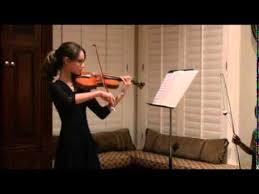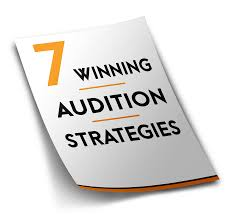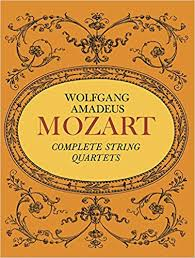3. PREPARING EFFECTIVELY FOR AN AUDITION
“The Concerti are wonderful, but the orchestral excerpts are often not of the same level”[1]
In my experience, many candidates do not have a clear idea about preparing orchestral excerpts and seem to often falter in this part of the audition. The actual preparation for an audition, that is, preparing the actual music, although very similar to preparation for a concert, has this unique aspect to be considered. In this chapter I shall first make some remarks about preparation of concerti and orchestral excerpts and also other repertoire sometimes required at auditions, such as Bach, chamber music and sight-reading. I shall then give some tips on how to prepare the music in general. This part of the chapter is based largely on my own experience as a teacher and member of audition committees for the last 36 years. I shall then go on to discuss mental and physical preparation, based somewhat on methods which I myself have developed, but also including researched and well-documented techniques. There are web-sites where it also possible to find this information, but I find, as an example, the site listed here quite vague and does not go into detail at all. [2] Some sites are quite entertaining and have some personal anecdotes, but I find the content very thin.[3]
Preparing your concerti
Generally, first rounds of auditions are extremely short and could last anywhere from three to six minutes. You could be asked to play only the exposition of a Mozart Concerto and one excerpt. You could also only play the exposition of your chosen Mozart Concerto. It is therefore useful to practise this aspect of the audition as well, so that you can feel you are in the flow of the music from the very beginning.[4] The first impression of your audition is so important. Committees are very sensitive to first impressions. Although not impossible to repair a bad first impression, the sound, articulation, intonation and general musicianship of your first moments are often determining. Practise the beginning of your Mozart concerto over and over so that you really feel comfortable from the very first moment and that you feel you can express yourself as freely as possible.
It is also good to take into account that if you pass the first round and you are asked to play your Mozart Concerto again, that you could be asked to start at the recapitulation. You could also be asked to play the exposition and the cadenza or until the recapitulation and the cadenza. It is good to take all of these possibilities into consideration when practicing for your audition. It is worthwhile practicing your concerto for instance, starting at the recapitulation, or playing the exposition and jumping then to the cadenza. Many candidates do not prepare after the recapitulation as seriously as the exposition. This is a big mistake and could end up costing you a job. Even if the exposition is wonderful, the committee will be unforgiving if the whole first movement is not prepared properly. Just to repeat, if the repertoire list says Mozart Concerto, first movement with cadenza, then make sure you prepare the entire movement! This of course also refers to the preparation of your romantic concerto. If the audition requirements state first movement, then this implies also with the cadenza. Getting through the audition with as few surprises as possible will help you survive better.
Preparing the excerpts
You will not know in which order or how many excerpts you will have to play. Practise the excerpts in a random order. Do not get into the habit of playing the excerpts in the order in which they have been given to you. It is possible that you will be asked to perform an excerpt but not starting at the actual beginning of the required part. Practise starting midway through an excerpt. As an extra training, turn the excerpts over so that you cannot see the music, then, shuffle the pages. Put the pages on your stand, then take your instrument. Then, turn over the page so that the music is visible. Play the excerpt immediately. This is good training to be able to be in the music of the excerpt immediately. What could also be helpful in this regard would be to write a key word or two at the beginning of each excerpt. Experiment with various words until you find something that works for you-something that will help you be in the character and style of the music from the first moment. These could be simple words like smooth, flowing, leggiero, melancholy, up-beat-anything that works for you.
It is always important to practice with a clear and focused idea about what you need to do technically to achieve your musical goal. For an audition with regards to the orchestral excerpts, this is an even more important aspect. Pay special attention to dynamics, tempi, and choice of style for each excerpt. Make sure your bow division is well thought out and not left to random choices at the moment of playing. Being very specific about all of these matters in your practicing will help you to be more focused and concentrated at the time of performance. Helpful to remember that practicing is “a refined art that partakes of intuition, of inspiration, patience, elegance, clarity, balance, and, above all, the search for ever greater joy in movement and expression”.[5] This also applies to practicing excerpts for an audition!
Make preparing the excerpts as difficult as possible for yourself. Practice a slow excerpt after a very fast one. Practice a very soft excerpt after having played one very loud. In this way, you can practice the control you will need to bring this off at an audition. Play through the excerpts without stopping. It is easy to forget to do this, since all the parts are so fragmented. Do not tune in between unless absolutely necessary. Try to emulate the situation at the audition as completely as possible.
It is very easy to lose track of tempi when playing orchestral excerpts. Make sure you play all of the excerpts with the metronome to check continuity of tempo. Check that second themes have the same tempo approximately as the initial theme. In choosing tempi for excerpts, it is wise not to choose too fast tempi for the fast excerpts. It is more important that every note is heard in an excerpt, than that you try to play what you consider an impressive fast tempo. On the other hand, it is good practice not to play the slow excerpts too slowly. A small difference in the slow tempo can make an excerpt sound either really beautiful or that you are struggling to maintain sound within the allowed bowings.
Make sure you take enough time between excerpts. Although you should not play the excerpts as if they were a piece in itself, make sure you finish the excerpt beautifully and wait before you move onto the next one. This is something which you should include in your practice. I have seen many candidates already stepping forward to take the next excerpt while still finishing the previous one. What seems like an eternity onstage is actually only a few seconds. You could time yourself between excerpts during practice and realize how long three seconds really is!
Pay special attention to the excerpts with spiccato. It is impossible to be successful at an orchestral audition, and survive in an orchestra for that matter, without an effective and reliable spiccato. The spiccato which one needs to effectively perform the Scherzo of Beethoven’s Third Symphony requires finesse and a light bow, very much different to the Finale of Tchaikovsky’s Violin Concerto. Make a point of choosing excerpts to practice outside of the required lists to develop a beautiful sounding spiccato, especially in pianissimo. If you are still experiencing difficulty with your spiccato, you could refer to the book “Basics” by Simon Fischer, in which he describes how to develop different kinds of spiccato.[6]
Besides practising the actual excerpt, it is of utmost importance to listen to the music and really study the score. It is so easy to hear if a candidate is not familiar with the music, even if the part is played perfectly. You should be able to hear the whole orchestra when you play an excerpt. If you are counting rests, you should hear the music. This aspect of preparation cannot be stressed enough. This is also the only way to feel comfortable about playing music, where you miss so much of the score. These days, it is so easy to listen to music on You-Tube. You can listen to many different recordings of the same work. Use these possibilities to learn the music, without trying to imitate the recordings! Listen to the music with your score in hand.
Preparing Chamber music
As previously mentioned in the chapter about repertoire, chamber music can be asked to be played as part of an audition. Besides studying the chamber music score itself, it would of course be helpful to round up some fellow musicians to play through the string quartet or whatever chamber music has been chosen. The benefits of this are obvious and you will feel more free in your performance if you have been able to learn the other parts of the chamber music through actual participation. Make notes in your part as to with whom you have certain entrances and with whom you play your part. If the part given to you is not marked, try and react quickly to bowings presented by the musicians from the orchestra with whom you are playing. Imitating the bowings quickly will also be an indication as to how alert you will be in the orchestra to pick up changes. Try also to have a similar bow division as the others. If you are playing second violin, try to imitate the first violinist as much as possible in this regard. If you are asked to play first violin in an ensemble (typically a string quartet), then show great leadership without exaggeration! You will see very quickly what style the musicians from the orchestra have. Try to adapt as quickly and as efficiently as you can in a short space of time. Make playing chamber music also part of your regular musical life. Do not wait for occasions to be created for you in which to play chamber music. Meet up with friends and fellow students to read through Mozart Quartets. Having a good feel for chamber music is of invaluable help when considering an orchestral career. Becoming a good chamber musician will mean also becoming a good orchestral musician. You will have studied and experienced what good ensemble playing means in all of its facets-intonation, rhythm, blend of sound, flexibility and generally being alert to your fellow musicians, all ingredients needed for a good orchestral musician.
Preparing Sight-reading
Being a good sight-reader, as previously mentioned in the chapter about repertoire, is of invaluable help as an orchestral musician. Orchestras often have three or even more programs in one week, so it is essential that your first contact with a new score, means reading it quite well. In preparation for audition, it is also helpful to have this quick reflex towards reading new music. Not only because sight-reading may be requested at the audition, but because you will have an advantage in preparing new lists of audition material. It is easy to practice sight-reading. You do not necessarily only need to sight-read orchestral repertoire. Sight-reading chamber music will help you to also improve your reflex. It is definitely something, in my mind, which can be trained.
General thoughts about preparation
Recording yourself
Taping yourself at practice sessions is very helpful. Although this is quite common practice, and not specifically related to audition preparation, it is good to incorporate this into your practice sessions as it usually raises your stress level slightly which will emulate the audition more. Try to listen critically to yourself without being negative! Try to improve on your performance in a positive way.
Make sure you practise standing up! Many people practise sitting down. Practise in the shoes which you plan to wear at the audition. It is also a good idea to practise once in the clothes which you also plan to wear at the audition. If you go out and buy a new outfit for the audition, make sure it is comfortable to play in. Check that you have enough freedom of movement in your arms and that the neckline is comfortable with the chin rest and the shoulder rest.
Playing from Memory
If you plan to play from memory, make sure you practice this seriously. Put the score away so that you are not tempted to look at it. If you are playing behind a screen, it would be good to consider that playing from the part will not be seen by the committee. If this gives you extra confidence, then do it by all means. If the audition is not behind a screen, then it would be good to consider the benefits of playing by memory. Playing without the score tends to give a more professional appearance to your audition. Try to weigh the benefits of playing by heart against the amount of extra stress you will have if you do not have the score in front of you. If you feel too much extra stress, just put the music on a stand and try not to look like you are reading the score too much.
Playing in different locations
Since you will not know the exact time of your audition, try and practice at different times of the day. If you are a morning person, make sure you go through your audition material later in the day. If you are not a good performer in the morning, make sure you get into the habit of playing your audition program early in the day. It could also be helpful to run up and down the stairs a few times (if you have them) or do jumping jacks and then play your program. This heightened heart rate will be similar to how you will feel at the audition!
Play in as many foreign environments as you can. Try and get away from the safety of your practice room and venture into places which have unforgiving acoustics. Do this often in preparation for your audition.
Preparing your instrument
Prepare your instrument for the audition. Perhaps it is a good idea to change your strings if they are old, but do this well ahead of time. If you feel your instrument is not responding well, have it checked by the luthier, to make sure no seams are open. Having a recently well rehaired bow will also help your sound production.
Many candidates borrow good instruments for auditions. This is of course possible, but it is important to play on an instrument which you feel completely comfortable with than one which is better on paper.
Performing regularly
Preparing effectively for an audition means also having as many opportunities as possible to walk onto a stage to perform. This includes regular performances as well. Try and create as many possibilities as you can for yourself to perform regularly. Do not wait for an all-important concert. Take any performance opportunity offered to you even if it means playing somewhere which you do not consider so interesting and it does not pay well. Every opportunity you have to perform will help you to gain the experience you need to learn to focus and concentrate and perform as closely as possible to your actual ability. Try and play for somebody every day leading up to an audition. It is important to practice how you hope to feel at your audition during your preparation. Of course some of your preparation will be devoted to careful thought about how you wish to execute the various works, but it is also import to practice being spontaneous and how you want to feel giving a strong communicative performance.[7]
Playing mock auditions
Mock auditions are a very effective way to prepare for the real thing. The more often you have gone through your program, the more comfortable you will fell at the actual audition. Try to simulate the actual audition situation as much as possible. Setting up something which resembles a screen is useful. Ask your friends, the “committee” to make the mock audition as difficult as possible for you. It is also useful to play for colleagues who are not violinists. Getting the musical input on your Mozart or Romantic Concerto can be invaluable. Consider always that committees are looking for artistry and musicianship and not only for “perfect” violinists.
There are also possibilities on-line to take part in mock auditions. The first Associate Concertmaster of the Los Angeles Philharmonic Nathan Cole, has set up an on-line audition challenge in which you can take part.[8] He also offers advice on your performance. Of course, this will cost something in the end, but you might consider taking part as an extra source of preparation.
Practising behind a screen
Generally, orchestras will announce if the audition will take place behind a screen or not. If nothing is said, it is still possible that the audition (generally the pre-round and first rounds but not the final) will take place behind a screen. It is important to include this event in your practice sessions. You can be creative about simulating a screen, if you have no access to a hall with a screen. You could hang a sheet between two points in your room and play behind it. Include this practice in your mock audition sessions. It can be very disconcerting to play behind a screen if you have not practiced this ahead of time. Consider also that the screen could be placed on the stage or directly in front of the committee.
Long term preparation
Get as much experience as you can, playing in orchestras during your student days. Take advantage of summer festivals where you can get good orchestral training.
Make preparing for auditions part of your musical education. Do not make your orchestral class at the Conservatoire the only time when you are thinking about auditioning. Do not just practise orchestral excerpts-play them and live them.[9] Study the orchestral repertoire just as you study your violin repertoire. Go to as many concerts as you can, and not just when a violinist is a soloist.
Getting through the first round of an audition means having a wonderful first movement of a Mozart Concerto. Getting through the final means also having a beautiful first movement of a romantic concerto in your repertoire. Make sure that when you leave the Conservatoire, you have two well-studied and often performed concerti in your repertoire and the same for many orchestral excerpts!
[1] Statement made by G. Dicterow, former Concertmaster of the New York Philharmonic in an interview 29/03/2017
[2] Kajeyamo, N. http://www.bulletproofmusician.com/ last seen 05/07/2017
[3] Millett,K. (2005) http://stringsmagazine.com/12-ways-to-ace-your-orchestral-audition last seen 05/07/2017
[4] Andreas Burzik offers four principles that will minimize the effort and maximize the effects of practicing http://www.thestrad.com/how-to-use-flow-to-make-the-most-of-your-practice/ last seen 07/05/2017
[5] Bruser, M. (1977) The Art of Practicing A Guide to Making Music From the Heart. New York: Bell Tower Foreword by Yehudi Menuhin.
[6] Fischer, S. (1997) Basics 300 exercises and practice routines for the violin. London: Peters Edition p.70




